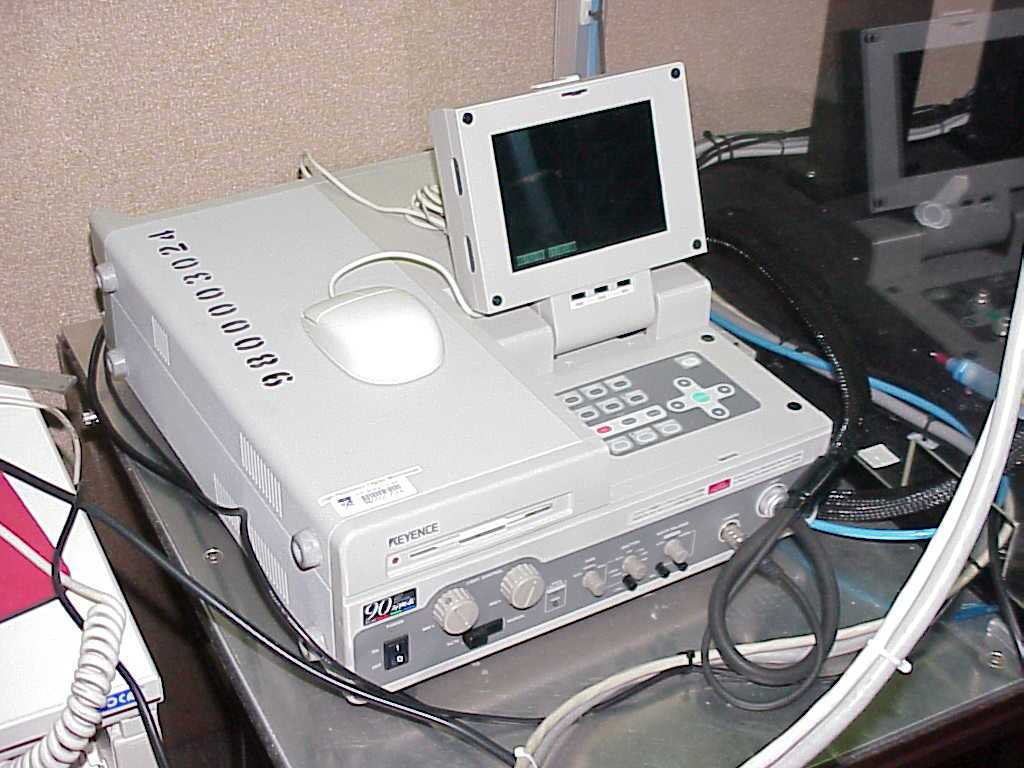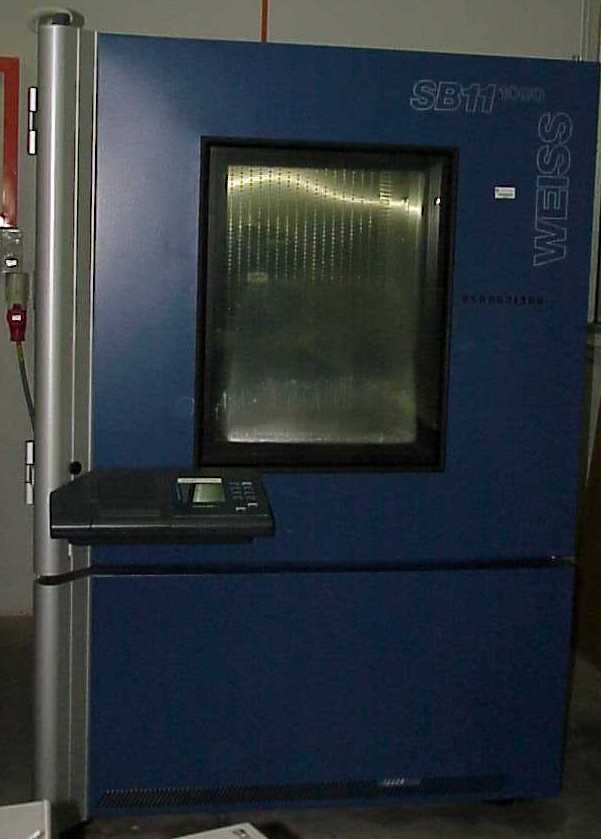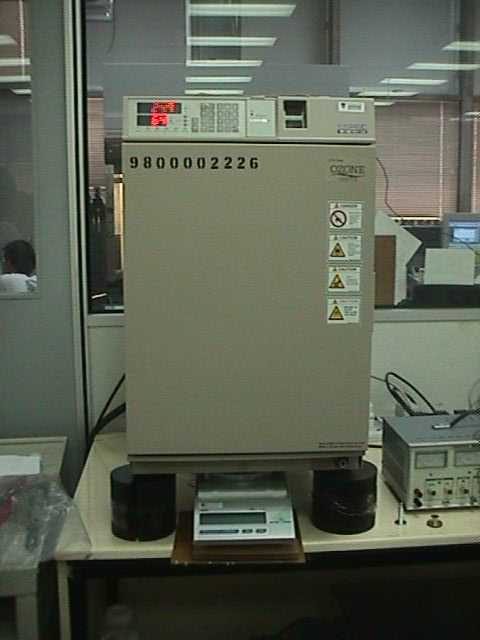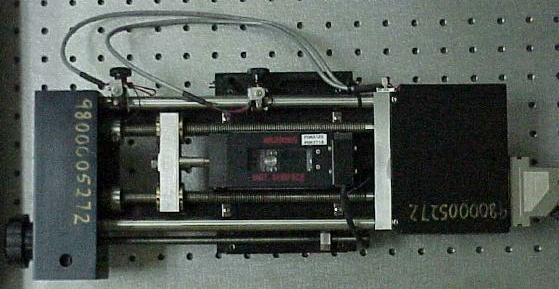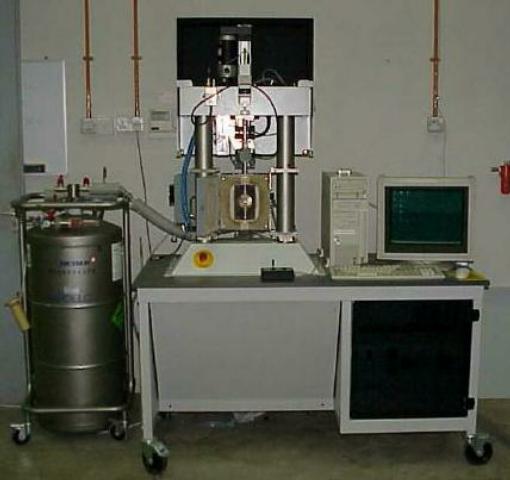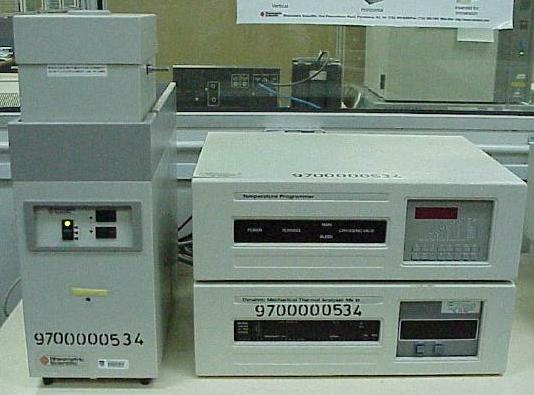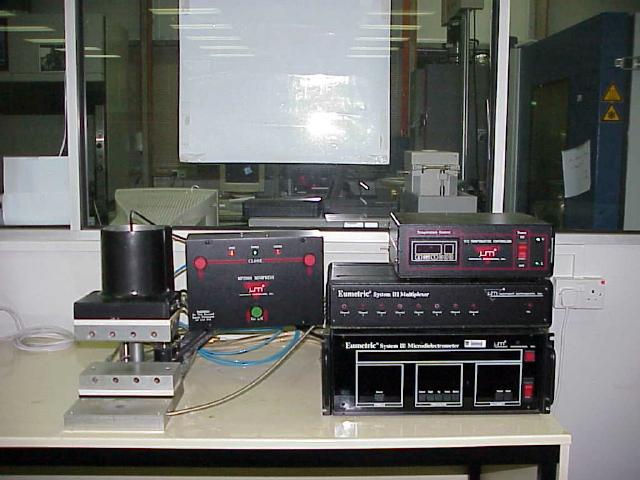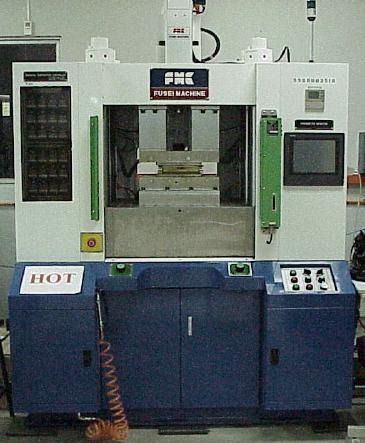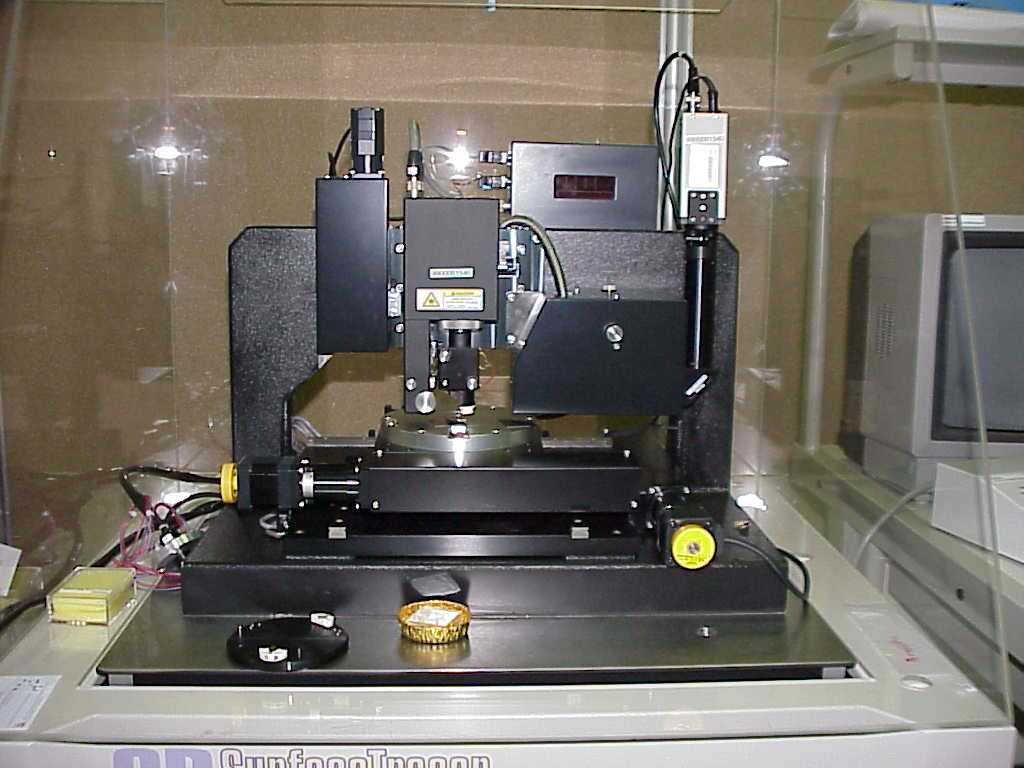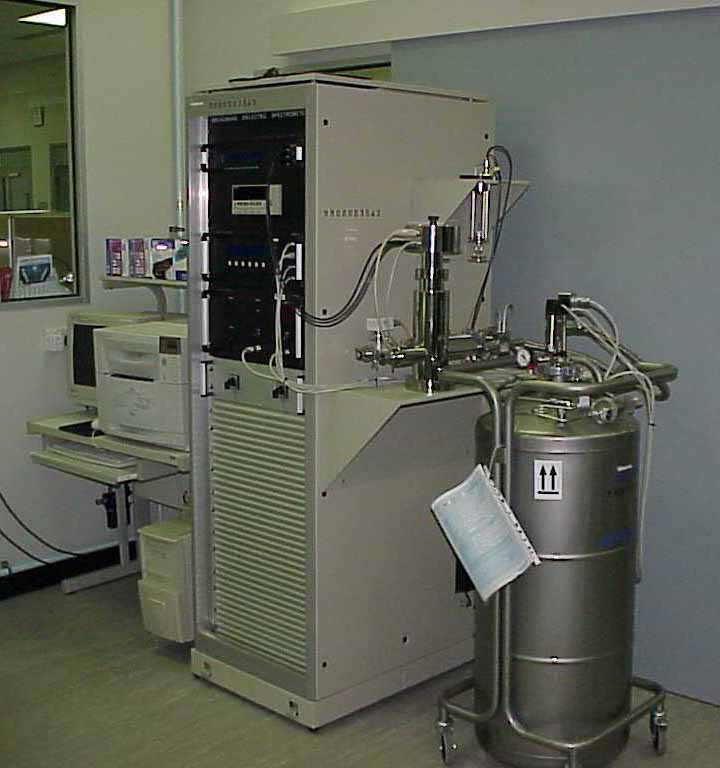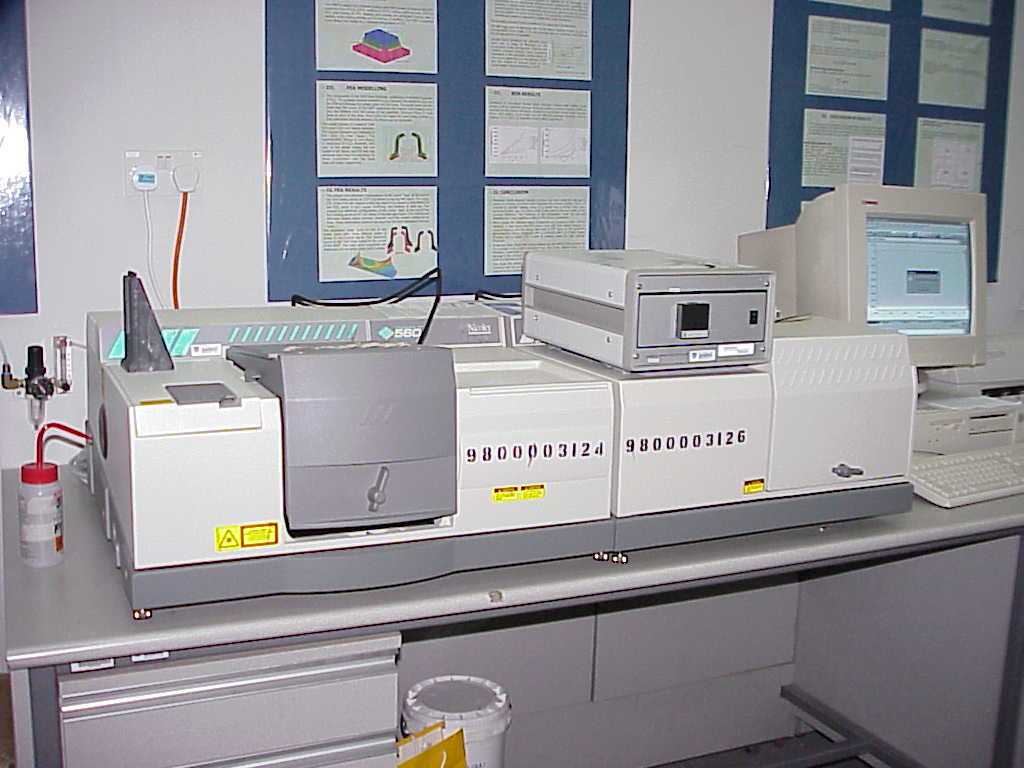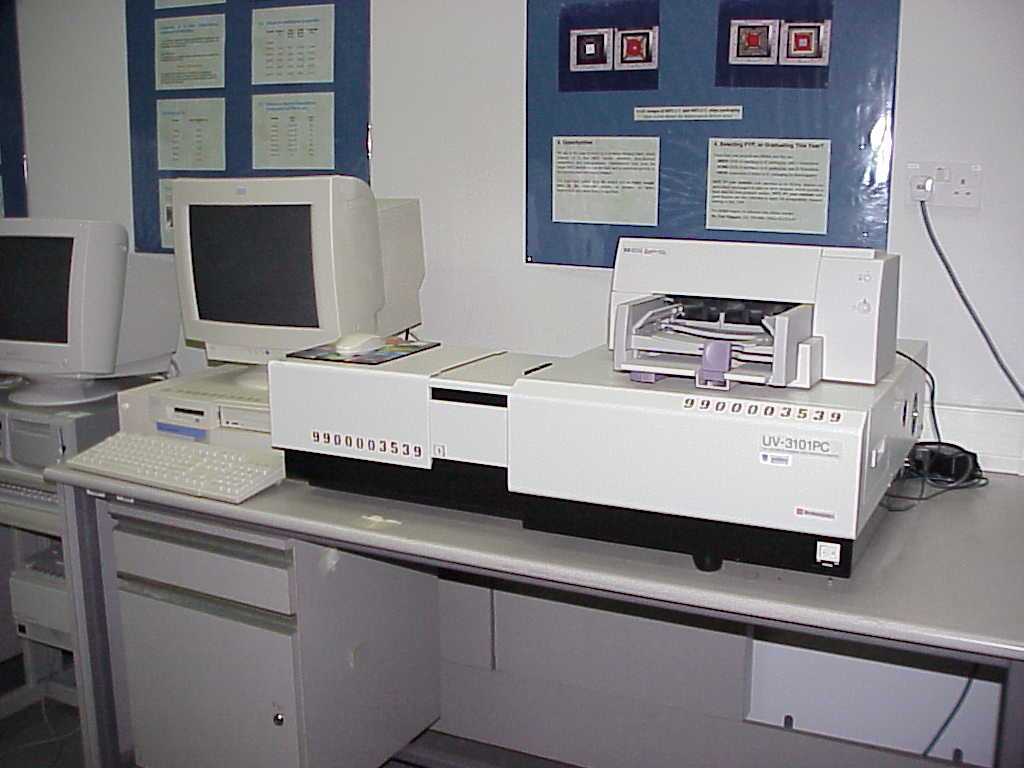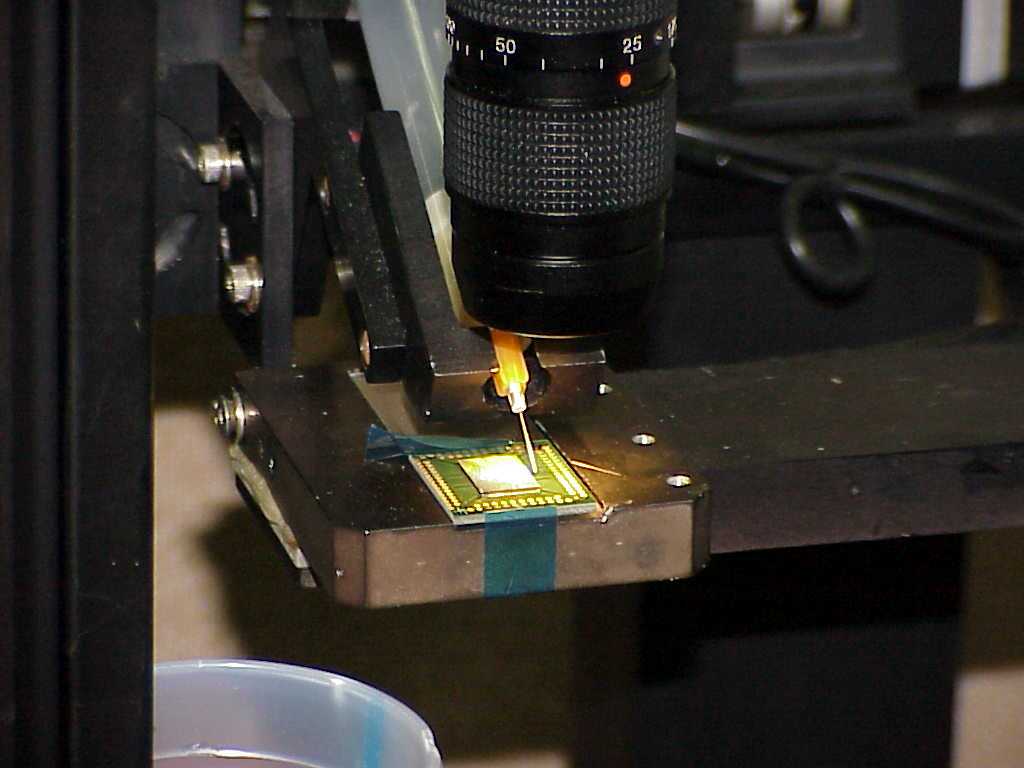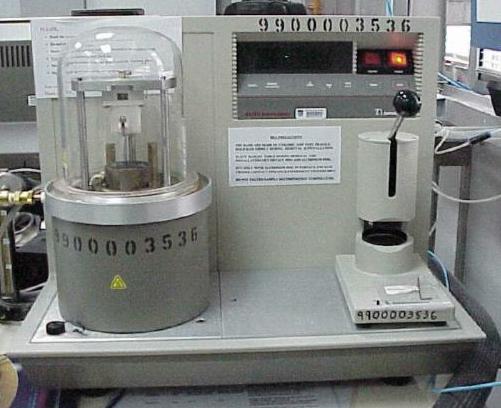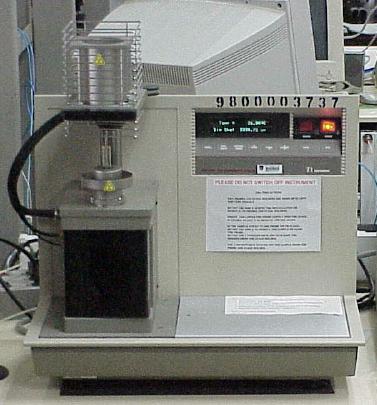Equipments
Portable High Resolution Digital Microscope
| Keyence Model VH-6300 |
|
| Zoom lens 175x, 800x | |
| The high resolution digital microscope allows images to be recorded and playback on a 3 1/4" floppy disk. Measurements of distance, area as well as radius can be performed on the image. Output to external monitor via RGB output cable, s-video terminal cable and BNC-pin cable are also available. |
|
| Weiss Technik Cold-Heat-Climate-Test chamber SB11/1000/40 |
|
| Capacity: 1000 Litres | |
| Temperature range: | |
| cold-heat operation: -40 to 180 degree C | |
| climate operation: 10 to 95 degree C | |
| Humidity range: 10 to 98 %RH | |
| Temperature constancy | |
| climate operation: +/-.1 to +/-.5degree C | |
| cold-heat operation: +/-.2 to +/-.5degree C | |
| Humidity constancy: +/- to +/- %RH | |
| Maximum total load: 200 kg | |
| Cooling rate: 2.0 degree C/min | |
| Heating rate: 1.9 degree C/min | |
| Manual, automatic and external operation | |
| Program (125 segments) and fixed value operation | |
| The Weiss temperature and humidity chamber is used for moisture absorption studies, conditioning of samples at various temperature and humidity loads and temperature cycling tests with/without bias. |
|
Espec Temperature and Humidity Chamber
| Tabai Espec Bench-top Model SH-220 |
|
| Capacity: 21 Litres | |
| Temperature range: -20 to 130 degree C | |
| Humidity range: 30 to 95 %RH | |
| Temperature constancy: | |
| +/-.3 degree C (–20 to 100 degree C) | |
| +/-.5 degree C (101 to 130 degree C) | |
| Humidity constancy: +/- %RH | |
| Temperature uniformity: | |
| +/-.5 degree C (–20 to 100 degree C) | |
| +/-.8 degree C (101 to 130 degree C) | |
| Humidity uniformity: +/- %RH | |
| Temperature heat-up rate: | |
| –20 to 130 within 50 min | |
| Temperature ramp-down rate: | |
| 20 to –20 within 30 min | |
| Manual, automatic and external operation | |
| Program (9 step/1 pattern) & fixed value operation | |
| The Tabai Espec bench-top temperature and humidity chamber is used for moisture absorption studies as well as to condition samples at various temperature and humidity loads. |
|
Miniature Materials Tester Model Minimat 2000
| Test mode: |
|
| Constant rate, stress relaxation, creep | |
| Deformation mode: | |
| Tensile, compression, 3-point bending | |
| Load range: 0.2 to 200 N | |
| Load beam resolution: 0.1% of full scale | |
| Stepper motor speed: | |
| 0.01 to 99.99 mm per minute | |
| Cross-head travel: | |
| 100 mm (45mm with temperature chamber) | |
| Cross-head speed: 0.01 to 100 mm/s | |
| Drive resolution: 0.15 microns | |
| Sample displacement: | |
| 99.99 mm in 0.15 microns steps | |
| Temperature range: –50 to 200 degree C | |
| Sample dimensions: | |
| 25 mm max width (20 mm with temp chamber) | |
| Data collection rate: 100Hz | |
| The Minimat is a bench-top materials tester, designed to perform tensile, compression and three point bend measurements on small samples. A heated chamber allows testing through glass transition. Simultaneous stress/strain and microscopy measurements of solids allow historical comparison of stress-strain data with observable mechanical changes, for example crack depth and propagation. |
|
Gabo Qualimeter-Eplexor Dynamic Mechanical Thermal Spectrometer (DMTS)
| Test mode: |
|
| Tensile, compression, single/double shear, 3-point bending, single/double cantilever | |
| Changeable force transducers: | |
| 25N, 150N, 500N. | |
| Temperature range: -150 to 500 degree C | |
| Frequency range: 0.0001 to 100 Hz | |
| Damping range: 0.0001 to 100 | |
| Dynamic displacement control: | |
| +/-.0025 mm to +/-.5 mm | |
| Static displacement control: | |
| 0.005 mm to 35 mm | |
| The Eplexor DMTS is used for dynamic testing of polymers, elastomers, biological materials, glasses, ceramics, metals, foils, fibers, resins, adhesives, pre-pregs, composites, lacquers, coatings. It measures the deformation, force, storage & loss modulus, and tangent delta. |
|
Rheometric Scientific Dynamic Mechanical Thermal Analyser Mk III
| Test mode: |
|
| Tensile, compression, 3-point bending, single/ dual cantilever bending, shear | |
| Force: Up to 13 N | |
| Temperature range: –150 to 500degree C | |
| Frequency range: 0.01 to 200 Hz | |
| Damping range: 0.001 to 9.999 | |
| Modulus range (E' / G'): | |
| 104 to 1012 Pa / 103 to 108 Pa | |
| The DMTA Mk III measures the viscoelastic properties (specifically modulus and damping) of a wide range of materials from soft solids, films and fibers to composites. Due to its low force value, it is most suitable for small sample dimensions. |
|
Micromet Instruments Eumetric System III Microdielectrometer with MP-1200/QC Minipress
| Frequency range: 0.001 to 100 kHz |
|
| Temperature range (Minipress): | |
| Ambient to 200degree C | |
| Temperature stability: +/-.5degree C | |
| Max heating rate: | |
| 20 degree C /min (controlled) | |
| 50 degree C /min (uncontrolled) | |
| Max cooling rate (uncontrolled): | |
| 100 degree C /min (Water cooled) | |
| Press pressure (max): 907 kg | |
| Platen dimension: 10.16 x 20.32 cm | |
| Conductivity options: Low, mid and high | |
| Sensors (for different conductivity range) Low conductivity, high conductivity, Inter- digitated electrode sensor (IDEX), Tool mount steel (TMS) | |
| The Eumetric System III Microdielectrometer with 8 channel multiplexer measures the dielectric permittivity and loss factor, gain and phase, admittance and phase, temperature, capacitance and resistance and offset and range. It is used for material analysis in research laboratories and for real time, on-line monitoring of important process variables such as viscosity, reaction rate, composition and extent of reaction. It is also used for monitoring and controlling polymer and composite processing in aerospace, electronics, plastics, composites, and chemical industries as well as university and government laboratories. The different conductivity options (low, mid and high) allow different sensing ranges, to monitor changes with very fast measurements, and to provide access to controlled experimental environments. |
|
Photomechanics Inc. Portable Engineering Moire Interferometry (PEMI) II
| Normal Sensitivity: | |
| 417 nanometers per fringe order | |
| Theoretical Enhanced Sensitivity: | |
| Up to 100X with fringe shifting | |
| Testing Area: | |
| 1.5mm x 2mm to 45mm diameter circle | |
| Optical Head Size: | |
| 200mm H x 200mm W x 135mm D | |
| The PEMI is a unique, powerful tool for quantitative whole-field displacement and strain measurement with high sensitivity. Strain due to thermal or mechanical loading can be measured. PEMI is suitable even for very small or soft components or structures, such as tiny solder joints and polymer layers in microelectronics. Applications in diverse fields include composite materials/structures, ceramics, fracture, residual strain, smart materials/structures and mechanical adhesive joints. |
|
| Fusei Machine Co. Transfer Molding Press Model FSTM125-7Ton-24 Point |
|
| Clamp tonnage: 125 Tons | |
| Transfer tonnage: 7 Tons | |
| Clamp stroke: 270 mm | |
| Transfer stroke: 350 mm | |
| Ejector stroke: 0-65 mm | |
| Clamp working pressure: 200 kg/cm2 | |
| Transfer working pressure: 112 kg/cm2 | |
| Transfer fast speed: 110 mm/sec | |
| Transfer slow speed: 0-25 mm/sec | |
| Transfer return speed: 150 mm/sec | |
| Heater capacity: 2-12 kW | |
| Motor power: 7.5 kW | |
| The transfer molding machine uses a monitor type control system including a multi-gang pot (M.G.P) system. Book molds are used in the transfer molding machine for molding tensile strength test specimens, fracture test specimens, adhesion test specimens as well as for spiral flow tests. |
|
| Shimadzu 3D Surface Tracer, SFT-9800 |
|
| Maximum scanning Range (X,Y): | |
| 100 micron X 100 micron | |
| Maximum measuring range (Z): | |
| 6 micron | |
| Maximum sample size: | |
| 150 micron X 150 micron X 20 micron | |
| The AFM measures surface conditions of a surface film such as micro-roughness, difference in surface, dust and flaws. It gives a three dimensional view of the sample surface. AFM also provides the particle analysis. The AFM operates in two modes; "contact mode" and "dynamic mode". These two modes require different kind of cantilevers. The microprobe is located at the tip of the cantilever. The AFM is equipped with a heating and cooling unit, to study the surface changes during heating or cooling the sample. The sample stage is heated or cooled with a temperature program from –90 to 300oC |
|
Novocontrol Dielectric Spectrometer
| Temperature: -150 – 400 degree C |
|
| Frequency: 0.1e mHz – 10 MHz | |
| Dc-bias: 0 – 10 V | |
| Sample specification: | |
| Liquids, solids (powders or films) | |
| Sample geometry: maximum diameter=40 mm | |
| Measured properties: | |
| impedance, tand, conductivity, resistivity, permittivity, permeability, capacity, admittance, inductivity | |
| The dielectric spectrometer measures minor changes in material properties as it is subjected to a periodic electric field in order to characterize its molecular kinetics. In order to measure as much quantitative data, the system covers a broad frequency and temperature range. Due to the high sensitivity of the measuring system, it is possible to detect transitions that cannot be defined with other techniques. Many key aspects of material properties such as molecular relaxations, phase transitions, conductivity, rate of blending or curing, etc. can be determined by this method. |
|
Novocontrol Thermally Stimulated Depolarisation Current Analyser
| Temperature: -150 – 500 +/-C |
|
||||||
| Frequency: -250 – 250 V | |||||||
| Sample specification: | |||||||
| Liquids, solids (powders or films) | |||||||
| Sample geometry: maximum diameter=40 mm | |||||||
| Measured properties: | |||||||
| impedance, tand, conductivity, resistivity, permittivity, permeability, capacity, admittance, inductivity | |||||||
TSC experiments:
The electrical response current to a polarization voltage or a short applied to the sample electrodes in general is not a constant, but is a value which depends on physical and chemical conditions. The global purpose of WinTSC is to measure, evaluate and display this discrepancy. With TSC techniques, especially dielectric relaxations in polymers can be characterized. Except for ideal resistive compounds, the sample current generally varies with the temperature, time, and other parameters such as polarization voltage. |
|||||||
| Nicolet Magna-IR 560 E.S.P. FT-IR and FT- Raman Module Includes: |
|
| DTGS and InGaAs Detectors | |
| XT-KBR Extended Range Beamsplitter | |
| Advanced OMNIC E.S.P. Software | |
| Series Software | |
| TQ Analyst Quant Software | |
| Raman and IR Sampling Accessories: | |
| Specac Golden Gate Heated Diamond ATR Accessory | |
| Wotton Liquid Hot Cell for Raman studies | |
| 180+/- Reflective Sampling Optics for Raman | |
| Spectra-Tech ARK Horizontal ATR Accessory | |
| Spectra-Tech HT-32 Heated Liquid Cell | |
| Spectra-Tech Model 300 Specular Reflectance Accessory | |
| KBr Pellet Press & Dies | |
The Nicolet FT-IR system installed in our Lab is a high-performance spectrometer that meets the most demanding infrared sampling requirements. The Nicolet Magna-IR 560 E.S.P. is a true digitally controlled FT-IR based upon advanced high speed digital signal processing (DSP) technology. In addition to providing the most precise and accurate control of the interferometer moving mirror available in the industry, the DSP allows the system to employ continuous digital dynamic alignment. Dynamic alignment provides exceptional long and short term stability characteristics and optimal spectral peak shapes. In addition, the DSP allows for interactive parameter selection with instant feed-back on changes to scanning velocity, signal gain and optical throughput and real-time system diagnostics. The interferometer provides better than 0.35 cm-1 spectral resolution and a signal to noise ratio of better than 30,000/1 peak-to-peak for one minute measurement time. The system is capable of rapid scan collection of 35 scans/sec. The Magna-IR 560 is configured to cover the Near and Mid-IR range from 9,600 to 375 cm-1 using an air-cooled source, XT-KBr beam splitter and DTGS detector. The system also includes a FT-Raman Accessory Module with a self-contained Near-IR (1.064 Ám) excitation laser. An additional InGaAs detector is mounted within the Magna-IR 560 for the Raman experiment. This provides for measurements of Raman shift from 3,600 to 100 cm-1 Stokes and 300 to 2,000 anti-Stokes. Switching between IR and Raman experiments is computer controlled allowing the user to quickly identify samples that appear similar in the infrared by their Raman spectral characteristics. The large Magna-IR 560 sample compartment easily handles traditional transmission experiments on films, solids and liquids, however, the capabilities of this system have been enhanced with a number of sampling accessories. These include the HT-32 Heated Liquid Cell which can be programmed to heat samples to a maximum 400degree C. The Model 500 Specular Reflectance Accessory enables measurements to be performed on films and coatings at angles of incidence from 20+/-to 85+/- The ARK Horizontal ATR Accessory is supplied with both flat and trough plate ZnSe crystals which permits the analysis of liquids, pastes, powders, films and solids without the need for tedious sample preparation. The Specac Golden Gate Heated Diamond ATR Accessory allows thermal experiments on a wide range of samples that might otherwise damage the standard ZnSe crystal. The FT-Raman Module includes gold-coated 180+/-reflective sample optics with computer-controlled optimization of the sample position. The Wotton Liquid Hot Cell can be mounted on this accessory for experiments that require temperatures above ambient. |
|
Ultraviolet, UV/VIS Spectroscopy
| Wavelength accuracy: +/-0.3 nm |
|
| Wavelength repeatability: +/-0.1 nm | |
| Discomposition: 0.1 nm less | |
| Stray light: < 0.00008% (220 nm) | |
| < 0.00005% (340nm) | |
| Photometric accuracy: +/-0.002(0.5ABS) | |
| +/-0.004(1ABS) | |
| Baseline stability: +/-0.000ABS./H. | |
| Baseline flatness: +/-0.001 ABS. | |
| Noise level: 0.0015ABS. less(500nm) | |
| Application: Transmittance and reflectance measurements. | |
| The UV spectroscopy is used for identifying and determining the characteristics of the organic compound. A UV spectrum obtained directly from an instrument is simply a plot of wavelength (or frequency) of absorption intensity (absorbance or transmittance). The data are frequently converted to a graphical plot of wavelength versus the molecular absorption. |
|
| Dispensing machine |
|
| Air pressure: 0-5 kPsi | |
| Time: 0-9.999 sec | |
| Heating plate | |
| Temperature: 25-200degree C | |
| Dispensing table | |
| X and Y axis length: 0-250 mm | |
| Z axis length: 0-50 mm | |
| Speed 0-200 mm/s for all three axis | |
| Digital camera | |
| Magnification 25x to 175x | |
| Monitoring distance 25.5 mm. | |
| Application | |
| Flip chip underfilling. | |
|
The XYZ dispensing table is used to underfill flip chip on board. It consists of a pneumatic dispensing machine, heating plate and three-axes DC servo motor controller. A digital camera system is used to observe and capture the flow behaviour during the underfilling process. |
|
| Frequency range: 0.003Hz-100kHz |
|
| Applied voltage: 1 volt | |
| Measured amplitude precision: 0.1% | |
| Phase angle accuracy at 1 kHz: 10-4 radians | |
| Tan delta sensitivity at 1 kHz: 1x10-4 | |
| Dielectric constant sensitivity at 1 kHz: 0.01 | |
| Dielectric constant range: 1-105 | |
| Loss factor range: 0 to 108 | |
| Ionic conductivity range: 10-5 to 1010 pmhos/cm | |
| Force setting range: 0-500N | |
| LVDT precision: 1.0 m m | |
| Temperature range: -150-500degree C | |
| Sensors: parallel plate sensor, sputter coated, ceramic single surface sensor, remote single surface sensor | |
| Temperature Control | |
| Isothermal stability: +/-.2degree C | |
| Optimum heating rate: 0.01degree C/min to 5.0degree C/min | |
| Optimum cooling rate: | |
| 0.01degree C/min to 10.0degree C/min (Down to ambient) | |
| 1degree C/minto5degree C/min(Down to–150degree C) | |
| Oven cool: 30 min (down time to 50.00degree C) | |
Thermomechanical Analyser (TMA): TA Instruments TMA-2940
Temperature range: -150degree C to 1000degree C |
|
| Heating rates: up to 200degree C/min. | |
| Samples: solid, film, fiber or powder form. | |
| Probes: standard expansion, penetration, | |
| micro-expansion, and film/fiber probe | |
|
The thermo-mechanical analyser measures the change in dimension of the sample with respect to a temperature program. Sample properties such as melting point, softening point, tensile modulus, compression modulus, glass transition, stress relaxation, creep and expansion coefficient are measured. |
|
| Load cell capacity: up to 50kN | |
| Samples: flat, round. | |
| Environmental chamber: | |
| Temperature range: -34 to +190 degree C | |
| Relative humidity: 0--100 % RH | |
| Uniaxial extensometer | |
| Gage length: 25mm | |
| Travel range: +12.5/-2.5 mm | |
| Temperature range: -100 to +175 degree C | |
| Specimen size: 2.5-14.0 mm diameter or | |
| 0.3-12.5 mm thickness | |
| Biaxial extensometer | |
| Gage length: 25 mm | |
| Axial travel: +1.2/-1.5 mm | |
| Traverse travel: +/-0.5 mm | |
| Temperature range: -100 to 150 degree C | |
| Specimen size: 3-34 mm diameter or | |
| 3-51 mm thickness. | |
The MTS 810 is driven by a hydraulic power system and has a loading capacity of up to 50kN. It can be used for constant rate, creep, relaxation, fatigue and fracture experiments. With an environment chamber attached, experiments can be carried out at sub-ambient to high temperatures and with humidity. |
|
| Application: | |
| Strain sweep, Frequency sweep, Time sweep, Temperature sweep. | |
| Measuring ranges: | |
| Max. torque: 150 mNm | |
| Min. torque: 0.00005 mNm | |
| Max. speed: 100 /min | |
| Min. speede: 0.01 CS/min | |
| Max. Frequency: 100 Hz | |
| Min. Frequency: 0.0001 Hz | |
| Number of impulses: 10000000 | |
| Strain resolution: 0.0000006 | |
| Specification: | |
| Autogap, Multiwave, Inertia correction, Micro-stress control, Normal force external optional, Normal force internal 15 N. | |
| Sensor system: | |
| Parallel plate sensor, Cone and plate sensor | |
Introduction The rheometer RS 150 is used to measure the visco-elastic behaviour of the fluid and soft solid. It consists of a temperature controller and microprocessor controlling the position of the sensor (Auto-gap). Drive motor with built-in temperature sensor allows compensation for coil heating at high torque. Remote and manually controlled lift with variable speed to preserve the fluid’s structure and ensure reproducible test conditionsOperating manual Switch on the main switch for the temperature controller and the control unit for the rheometer and start the software. Time sweep Select auto-gap for measurement. For parallel plate sensor, select a gap height. Heat the sensor to the required temperature setting and place the sample on the sensor. Move the measuring plate to the required height and start measurement. Temperature sweep Select a heating rate and choose thermo-gap for measurement. Place the sample on the sensor. Move the measuring plate to the required height and start measurement. Frequency Sweep Select the initial and final frequency. Choose a suitable temperature settings. Place the sample on the sensor. Start measurement. |
|

